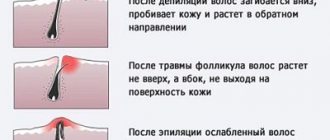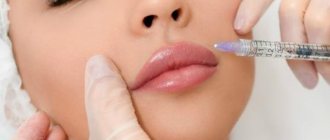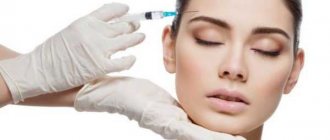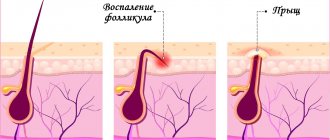Posted on Sep 2nd, 2019
by Olya
Categories:
- Dependencies
“Aesthetic Guide” presents to your attention the second part of an article by the head of a clinic in the city of Bochum (North Rhine-Westphalia, Germany), German cosmetologist and plastic surgeon Jan Balczun, about the side effects and complications caused by dermal filler injections
V.
In the first part, the author talked about the types of fillers and their characteristics, spoke in detail about mild and some moderate complications, as well as ways to combat them.
In the second part, Jan Balchun examines other moderate and severe complications, giving each a detailed description and prescribing a treatment plan.
Moderate complications
Change in skin color
No matter what filler is used during the procedure, there is always a risk of skin discoloration or discoloration. A slight redness that occurs almost immediately after the injection is a typical side effect and usually goes away within a few days - a common inflammatory reaction in the injection area.
If after this period the redness does not disappear, this may lead to a hypersensitivity reaction. Its treatment should be similar to that of rosacea: with topical steroids and oral tetracycline or isotretinoin. Vitamin K applications also give good results.
Another risk in the injection area is excessive distension, caused either by the product itself or by excessively active movements of the syringe. It can lead to neovascularization, which usually resolves in 3-12 months without treatment. If neovascularization worries the patient, laser cosmetology will come to the rescue. The choice of laser depends on the size of the vascularity: the list of options includes the 532 nm KTP laser, 585 nm copper vapor diode laser, 585 nm pulsed dye lasers and IPL pulsed light therapy.
As for the relationship between hyaluronic acid fillers and the Tyndall effect, recent research suggests that the blue tint is actually due not to the effect itself, but to the reflective properties of the skin. Since there is no point in waiting for the product to dissolve in the body on its own, treatment should begin with the use of hyaluronidase. If this is not enough (which is possible if the HA crosslinks too tightly), an incision and extrusion/removal of the drug can be carried out within 12 months.
According to the National Plastic Surgery Data Bank, in 2013, 22% of all cosmetic procedures were performed on racial and ethnic minority patients. Skin of color tends to become hyperpigmented after trauma, and since dermal filler injections represent minor trauma, post-inflammatory hyperpigmentation is a common problem after contouring procedures, especially for Fitzpatrick skin types IV-VI.
If hyperpigmentation occurs after drug administration, a whitening agent (eg, topical hydroquinone) along with Retin-A and a strong daytime sunscreen should be used in the first stage of treatment. If this does not help, the next step should include IPL and laser treatments. To minimize the risk of post-inflammatory hyperpigmentation, the number of injection sites should be limited.
Malar edema
This complication can occur as a reaction to any filler that is used to fill the infraorbital cavity or nasolacrimal groove.
In a retrospective study, 12 of 51 patients (23%) who underwent infraorbital socket correction with hyaluronic acid filler had prolonged swelling for an average of 5.4 months.
As part of the dissection cadaver study, scientists were able to identify the malar septum - a fascial structure leading from the orbital ridge, above the arcus marginalis, to the skin of the cheek, approximately 3 cm below the outer corner of the eye. The malar septum divides the SOOF (suborbicularis oculi fat) into superficial and deep sections. While the lymphatic drainage of the deep compartment flows into the buccal fat, the superficial compartment, in turn, compromises this process.
This lymphatic barrier is very important and worth remembering; By introducing the drug superficially, into the malar septum, you can enlarge and inflate it, which will make it impermeable to lymphatic fluid - this, in turn, will lead to the accumulation of fluid and malar edema. Since any conservative therapy does not cope well with this problem, if it occurs, it is necessary to introduce hyaluronidase to dissolve the compromising HA.
To avoid malar edema, the injection must be carried out in the deep section, and the filler should only be based on hyaluronic acid.
Nodular neoplasms
If a patient develops nodular tumors after an injection, it is important to properly evaluate the impact that treatment has on the patient. For example, some nodes are noticeable but not noticeable, in which case it would be better to leave everything as it is and wait and watch the dynamics.
Other neoplasms may require immediate action from the doctor. Typically, these delayed-effect nodules persist for weeks or even months and can subsequently be classified as inflamed or non-inflamed.
Fibrosis after hyaluronic acid
Any cosmetic and especially plastic manipulations can be accompanied by general reactions of the body, which depend on individual sensitivity. When injecting fillers, you have to deal with many similar complications; salons and companies are often silent about them.
Local anesthesia is always used during filler injection. But despite this, a certain degree of discomfort arises. This is due to the following:
- The diameter of the needle for introducing filler is sometimes quite large. Many solutions (including hyaluronic acid) cannot technically be passed through a small and thin needle.
- Most fillers are quite dense in nature. They roughly “pull apart” the tissue as the specialist injects the solution subcutaneously. This causes discomfort.
- Fan-shaped movements of the needle are often used during filler injection. This causes irritation of more nerve endings, which is accompanied by noticeable pain.
Many filler manufacturers, taking into account this pain aspect, produce a ready-made solution with the addition of an anesthetic, most often lidocaine.
Fillers can be injected into several areas at once, or in individual places. Each area on the face hides its own dangers and the most common complications.
Hematomas of various sizes often appear in the upper third of the nasolabial fold. This is due to the intensive blood supply to these areas. There is also an increased risk of recurrent herpes infection. Therefore, anyone who is prone to the appearance of these rashes is recommended to take a course of antiviral drugs before and after the injection of filler.
Skin necrosis in the area of the nasolabial fold often occurs, which is complicated by the addition of a secondary bacterial infection.
Under the eyes
This area is one of the most sensitive to all kinds of influences. Even minor trauma leads to hematomas that “blur” up to 3-4 cm. It takes up to several weeks for them to completely disappear.
When fillers are injected into the area under the eyes, tissue swelling almost always occurs. To prevent this complication, it is recommended to apply ice to the gel injection area.
Filler injections are most often performed in this area. The following complications are possible:
- Swelling for 10 days or more.
- Formation of hematomas due to good blood supply to the lips.
- Recurrence of herpetic infection.
- Formation of knots both outside and inside the lips. The location of the seals on the side of the oral cavity can interfere with chewing and bring a feeling of constant discomfort when speaking. They can be removed surgically, as well as conservatively using physiotherapy, injections of enzyme preparations, etc.
Inflammatory nodule of the left lower lip after injection of hyaluronic acid
If your face hurts after fillers, this does not mean the development of pathology or a serious complication. Doctors consider this sensation as a side effect that does not require medical intervention or the use of any medications, and ceases to bother you 2-4 days after the procedure. Why does facial pain occur?
- the skin is injured during the injection of fillers, punctures are made in the deep layers of the dermis - pain is a natural reaction of nerve endings;
- fillers fill the voids, after which the soft tissues stretch and take a new position - pain means adaptation of the dermis to new conditions;
- human skin is too sensitive and reacts inadequately to any impact.
If the face does not begin to hurt immediately, but 5 or more days after the manipulation, then this may mean infection in the punctures, the development of inflammation - the help of a doctor will be required.
If the recovery period after filler injections is accompanied by the formation of atypical lumps, then this is called facial fibrosis. If this happens during the first 24 hours and persists for another 72 hours, then there is no need to seek medical help - the phenomenon is natural and does not pose a danger to the general health of the patient.
But if the seals persist for a longer time, you must undergo an examination by a cosmetologist.
Causes of the problem:
- inadequate reaction of the body to the injection of filler - tissue rejects it as a foreign body;
- low quality hyaluronic acid;
- moving the filler under the skin;
- there is an increased production of fibroblasts, which causes intensive growth of connective tissue;
- superficial injection of filler;
- incorrect calculation of the drug dose.
These fillers are considered one of the safest and most biocompatible. Hyaluronic gel attracts liquid, so there is always tissue swelling at the injection sites. This filler often migrates from the injection area. Over time, it resolves and the procedure has to be repeated.
Women often complain of a “hollow” under the eyes due to the presence of wrinkles in the area of the nasolacrimal groove. The defect can be easily corrected with fillers. But you need to be prepared for tissue swelling and infraorbital hematomas.
Such materials are practically never used. Non-absorbable gels always shift over time, distorting the shape of the face. They can also compress important venous and arterial vessels, disrupting the nutrition of the tissues of the area.
Chronic inflammation is always present at the injection site of such gels, which leads to excessive growth of connective tissue and rejection of the filler.
If after injection of filler an infection has entered the dermis, the following symptoms will indicate this:
- pain in the area of the pathological focus is constantly present, has a pulling/aching nature, and can spread to the entire face;
- body temperature rises to low-grade levels;
- the skin at the site of development of the pathological process is very hot to the touch, “burning”;
- the face turns bright red.
Additionally, swelling, the formation of compactions, and tubercles with visually detectable purulent contents are noted.
Fibrosis is a thickening of connective tissue that forms after the introduction of hyaluronic acid. It can form as a complication of contouring or as a consequence of the body’s individual reaction to the injected substance. The main causes of fibrosis are:
- development of the inflammatory process at injection sites;
- violation of manipulation technique;
- rejection of a foreign substance by the body;
- movement of injected hyaluronic acid under the skin;
- vascular damage (puncture);
- violation of the rules of the rehabilitation period by the patient.
Pronounced symptoms of fibrosis are:
- the appearance of hard, dense formations at injection sites;
- the formation of a clearly defined tumor that does not move with intense palpation;
- mild discomfort in areas of fibrosis formation.
This complication after the introduction of hyaluronic acid is severe and late, occurring on the 3-5th day of the recovery period. With multiple compactions that are determined visually, doctors talk about granuloma - most often it occurs during manipulation of the lips.
The first symptoms of fibrosis of facial tissues after filler appear on days 4-6 of the recovery period. Most often present during anti-aging procedures on the lips, but can begin to develop anywhere. Treatment of fibrosis involves the use of the following:
- steroid hormonal drugs - injected directly into the changed areas of facial tissue, helps only in case of immune rejection of hyaluronic acid;
- cryodestruction and electrocoagulation procedures are effective only against superficial seals;
- laser and radio wave therapy - at least 5 procedures will be required and no doctor will guarantee a positive result.
Laser therapy
If signs of fibrosis appear in the nasolabial lips after fillers, then the only radical solution to the problem is to receive injections of hyralunidase: an enzyme that dissolves hyaluronic acid and ensures its rapid removal. No amount of physiotherapeutic procedures will help solve the problem.
If the patient does not consult a doctor in time about fibrous formations in the nasolabial lips, then a full-fledged surgical intervention will be necessary to correct the situation. It can lead to additional complications:
- wound infection;
- bleeding;
- tissue necrosis.
Fibrosis
Rehabilitation after fillers requires the patient to follow certain rules:
- avoid exposure to heat, refuse to visit the bathhouse, sauna and take a hot bath for 1-2 weeks;
- exclude excessive physical activity for 10 days, but moderate exercise is completely acceptable;
- for the first 2 days do not use decorative cosmetics;
- any care after fillers should be carried out by professional, high-quality cosmetics;
- For 2 weeks, touch the injection site of hyaluronic acid as little as possible, do not put pressure on it, and refuse massage.
You should give up decorative cosmetics
Inflammation cannot be considered a side effect. Despite the complete biological compatibility of non-sulfonated glycosaminoglycan, immediately after its administration, the internal organs activate their classic protective mechanism against “external irritants”. After a few days, all biological processes are normalized, and inflammation quickly disappears. If this doesn't happen:
- During the puncture, an infection entered the body. This does not mean that the cosmetologist did something wrong; maybe the injections only “activated” the viruses that had entered the tissue a few days before the injections;
- The woman was diagnosed with autoimmune diseases, which, in response to the absorption of the cocktail, began to inflame the treated area.
These two points are diametrically opposed. In the first case, the woman must take pharmacological agents, in the second - steroids, which dampens the effect of the local immune reaction. If steroids are injected into an area with a bacterial infection, the situation will only worsen, with the likely formation of massive suppurations and further scarring. Therefore, it is extremely dangerous to self-medicate; you need to urgently make an appointment with a specialist for qualified advice.
Leading cosmetology companies claim that fillers do not harm the body; unscrupulous clinics are to blame. It is not true. Despite the frequent use of anesthetic gel, the sensations from the procedure can be unpleasant.
Conclusion
The dermal filler market has expanded significantly in recent years. Currently, fillers can not only smooth out wrinkles, but also restore volume in many areas, thereby changing the overall condition of the face.
However, to achieve decent results, the doctor must have a thorough understanding of the individual characteristics of the materials used, including indications, contraindications, as well as the prevention and treatment of any possible side effects, if they are unavoidable.
There is not a single filler that does not have side effects, but the likelihood of their occurrence is sharply reduced if the specialist is familiar with the range of both the fillers themselves and the means that stop their effects. Also, thanks to a deep knowledge of anatomy, mastery of various techniques and the ability to create an individual treatment plan for patients, almost all serious side effects can be avoided.
Source: Prime International Journal of Aesthetic and Anti-Aging Medicine
In aesthetic medicine, any complications after procedures are a disaster, because the concept of beauty does not fit in with side effects. And while patients can forgive the doctor for hematomas and swelling, the occurrence of the Tyndall effect, when the dermal filler is visible through the skin, is unacceptable.
Especially for readers of estet-portal.com, a specialist in the field of aesthetic medicine, doctor, Professor Benjamin Asher spoke about how to prevent the Tyndall effect, as well as what to do to eliminate an unwanted side effect.
Causes of the Tyndall effect
B.A.: The Tyndall effect occurs when the hyaluronic acid-based dermal filler is injected at the wrong level, namely too superficially, or when too much of the product is injected. The Tyndall effect can either become noticeable during the procedure or appear a few days after it.
Most often, the Tyndall effect is observed in people with thin skin, especially in the area of the nasolacrimal groove.
The older the patient, the higher the likelihood of the Tyndall effect, since with age the skin of any person becomes thinner and thinner. Therefore, you need to be careful, because the risk of getting this unwanted side effect increases not only in the area of the nasolacrimal groove, but also in other correction areas.
Side effects after a few years
When injecting fillers, consequences can occur even after many years:
Fibrosis is a strong proliferation of connective tissue, but it is worth noting that the appearance of fibrosis is a normal phenomenon, this is how the body responds to the appearance of a foreign body in the body - filler. But if this process becomes uncontrollable, then as a consequence, after a few years, seals appear that are not only palpable, but also protrude above the surface of the skin, stretching it.- Scarring - this pathology occurs only in those patients who have a tendency to form keloid and peripheral scars on the skin. In this case, the wounds from the injections do not heal, but begin to turn into scars. This happens because the direct contraindication to the “beauty injection” was ignored.
Some women refuse the injection of fillers because they believe that it can stretch the skin, and after resorption it will become even more wrinkled - this is a myth.
Hyaluronic acid, which is part of the filler, tightens the skin, as it stimulates the production of its own elastin and collagen, the face becomes natural with the natural elasticity of the skin.
When the gel is introduced, the subcutaneous layer is filled with the required amount of filler, as a result of which the wrinkle is smoothed out, volume is restored, tissue is strengthened and the skin becomes more elastic. In addition, modern fillers for nasolabial folds do not just create a visual rejuvenating effect. They improve cell synthesis and stimulate the production of collagen and elastin, which are an important part of the young dermis.
The duration of positive changes from “beauty injections” is influenced by the patient’s age, skin condition, and facial activity of his face. But the durability of the effect also depends on the type of filler chosen. Each type of filler has its own duration of action.
Fillers based on calcium hydroxyapatite and polylactic acid are more durable; their effect lasts up to two years. But this positive characteristic has an important drawback: if the patient is dissatisfied with the changes made, it will be difficult to return everything to its original state, and you will have to put up with such a persistent effect.
If the problem occurs despite taking all necessary precautions, it can be corrected using the following methods:
- Massage. The treated areas should be massaged to gently distribute the drug. This method is effective only if it is performed directly during the procedure.
- Excision of the injection. The method involves removing excess material using a needle.
- Aspiration. An incision is made in the damaged area, after which the filler is sucked out using a needle and syringe.
- Hyaluronidase. This is an enzyme that dissolves hyaluronic acid and is used to correct any unsatisfactory results with its use.
How to avoid the Tyndall effect
B.A.: Most often, doctors encounter the problem of the Tyndall effect when working in the area of the nasolacrimal groove. To avoid this, it is necessary to introduce filler at the level of the deep fat compartment, working as deeply as possible. It is also best to work in this area using a cannula in order to avoid vascular complications.
The deeper you inject the filler, the less likely the Tyndall effect will occur.
It is also important to inject a small amount of filler, because even if you work deeply, you must not forget about the diffusion of the dermal filler, which in any case will rise a little after the injection.
The more you administer the drug, the greater will be its diffusion. Therefore, in order to ensure a good result of correction of this area without side effects, it is necessary to use a minimum volume of filler (0.2 - 0.5 ml) and work in the area of the deep fatty compartment.
Read the latest articles on Telegram!
What to do if the Tyndall effect occurs
B.A.: There are situations when you did everything correctly, but due to the fact that the patient has very thin skin, a slight translucency of the filler occurs. The best solution in this case is to immediately introduce hyaluronidase, which will quickly and painlessly solve the problem of the Tyndall effect.
I do not recommend injecting hyaluronic acid dermal filler into this area again in this patient because the likelihood of a reoccurrence of the Tyndall effect is quite high. In this case, the best alternative would be lipofilling of the problem area.
February 18, 2015
This is an enzyme that can be injected into the skin to dissolve hyaluronic acid (many gel fillers are made from hyaluronic acid) and remove swelling, excess gel and asymmetry.
Under the eyes
Hyaluronic acid is often injected under the eyes to achieve the following goals:
- Improve skin condition.
- Get rid of wrinkles.
- Increase skin elasticity.
- Remove dark spots under the eyes.
The last reason is the most popular. But the skin in this area is very thin. Because of this, when hyaluronic acid is injected into this area, the likelihood of any side effects occurring is highest. The skin is very sensitive, so the cosmetologist administers an anesthetic half an hour before the procedure.
Next, the area under the eyes is treated with an antiseptic. The injection is administered according to a special scheme for the eye area to avoid mistakes. The insertion site is sealed with a special plaster to prevent infections.
To prevent various complications, it is recommended to apply ice to the area where the gel is introduced; this will also help reduce swelling. Swelling most often occurs within 2-7 days. But to determine its nature, you need to re-visit an aesthetic medicine specialist after 1-2 days.
Problems after gels that can be solved with hyaluronidase
- Swelling/Bumps: Hyaluronidase may be injected to dissolve severe swelling from the filler.
- Gel unevenness: appearance smoothing.
- Infections: For injection-related infection, hyaluronidase should be used (if hyaluronic acid filler was used).
- Bluish tint under the skin due to dermal filler (Tyndall effect): this can be solved.
- Asymmetry: This can be corrected with hyalase by injecting it on the larger side to bring the size to match the other side.
- Oversaturation with filler: this can also be corrected with an enzyme injection (for example, to reduce too large lips after they have been enlarged).
- The filler was injected into the wrong place: this can be corrected.
- Vascular Complications: If an artery becomes blocked during the filler procedure, resulting in decreased blood flow to the skin, hyaluronidase should be administered immediately to try to prevent skin necrosis in the treated area.
How does the procedure work?
The patient is assessed based on the collected data and examination, then treatment is discussed. The risks of side effects are also discussed. Photos are taken.
If it is possible to use a needle to remove the aggregate, then this is the preferred option for hyalase treatment and will be carried out. In addition, for asymmetry, if adding a product will give a better cosmetic result, then this is also discussed.
A trial injection of the enzyme into the skin of the forearm is possible if the specialist is concerned about a possible allergy.
The first dose for the procedure will be smaller to avoid allergies (which are more common with higher doses)











